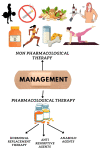Postmenopausal Osteoporosis: A Literature Review
- PMID: 36299953
- PMCID: PMC9586717
- DOI: 10.7759/cureus.29367
Postmenopausal Osteoporosis: A Literature Review
Abstract
A substantial proportion of the population of females in India falls in the perimenopausal and postmenopausal age groups. One of the complications associated with older age in women is the weakening of bones and the fall in bone mineral density (BMD). This has a severe debilitating consequence in a woman's life and leads to reduced quality of life along with a greater incidence of fractures. If the fracture involves the hip or the vertebrae, it can cause immobility and be devastating. Postmenopausal osteoporosis is linked with the deficiency of estrogen that occurs with the cessation of the function of the ovaries as age progresses. The function of estrogen in the bone remodeling process is very well understood after years of research; estrogen plays a part in both the formation of bone as well as the prevention of the resorption of bone. A diagnosis can be made by dual-energy X-ray absorptiometry (DEXA). It is the gold standard and can spot low bone density at particular sites. The treatment options are selected according to the severity and rate of progression and factors pertaining to each patient. All postmenopausal women should be made aware of this disorder, and they should be encouraged to cultivate a healthy lifestyle through the implementation of a proper diet and inculcation of a regular exercise routine. Smoking and drinking alcohol should be limited, and calcium and vitamin D supplementation should be started in all women of the postmenopausal age group with or without osteoporosis. In patients who have been diagnosed with the disorder, pharmacological intervention is done. Drugs should be selected based on their side effects and contradictions. Follow-up is essential, and patient compliance should be carefully monitored. This article attempts to review the existing literature on this very prevalent disorder to spread awareness about it so that all postmenopausal women can take the necessary steps to prevent the weakening of their bones, and deal with its progression.
Keywords: bone formation; bone mineral density; bone remodelling process; bone resorption; dual energy x-ray absorptiometry; estrogen; fractures; postmenopausal osteoporosis.
Copyright © 2022, Bhatnagar et al.
Conflict of interest statement
The authors have declared that no competing interests exist.
Figures




References
-
- India - Sample registration system (SRS)-statistical report. [ Aug; 2022 ]. 2019. https://censusindia.gov.in/nada/index.php/catalog/40526 https://censusindia.gov.in/nada/index.php/catalog/40526
-
- Postmenopausal osteoporosis - an Indian perspective. Rajan R, Paul J, Kapoor N, Cherian KE, Paul TV. Curr Med Issue. 2020;18:98.
-
- Nayak NK, Khedkar CC, Khedkar CD, Khedkar GD. Encyclopedia of Foods & Health. Vol. 1. Amsterdam, Netherlands: Elsevier; 2016. Osteoporosis; pp. 181–185.
Publication types
LinkOut - more resources
Full Text Sources
